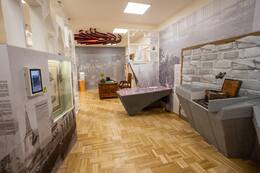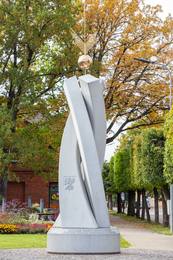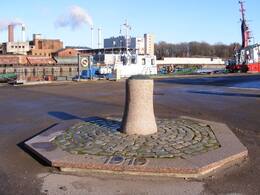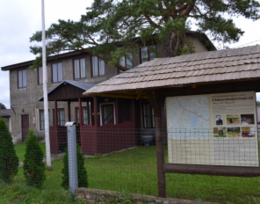Latviešu pagaidu nacionālā padome (LPNP)
I Pirmais pasaules karš, I Neatkarības kari
Latviešu pagaidu nacionālā padome (LPNP) – latviešu politiskās pārstāvniecības organizācija, kuru nodibināja 1917. gada novembrī Valkā (angļu Latvian Provisional National Council, vācu Lettlands Vorläufiger Nationaler Rat, krievu Латышский временный национальный совет).
LPNP deleģēja latviešu politiskās partijas un sabiedriskās organizācijas. Šī organizācija līdz Latvijas Tautas padomes sanākšanai (17.11.1918.) starptautiski aizstāvēja latviešu tautas pašnoteikšanās tiesības. LPNP mērķis bija iestāties par vienotā un etnogrāfiskā teritorijā apvienotu latviešu tautu, pārstāvēt tās intereses nākamā miera konferencē un rūpēties par Satversmes sapulces sanākšanu. Tās uzdevumi – sasaukt Latvijas Satversmes sapulci, kas lemtu par Latvijas iekšējo iekārtu un “attiecībām uz ārieni”; gādāt par izklīdušās tautas atgriešanos dzimtenē; protestēt pret jebkādu Latvijas piesaistīšanu Vācijai; prasīt Latgales atdalīšanu no Vitebskas guberņas un pievienošanu Latvijai.
1917. gada 17. novembrī (j.st. 30.11.) Valkā LPNP nodibināja 29 delegāti no 13 pilsoniskajām partijām un organizācijām. Pēc nodibināšanas sākās LPNP 1. sesija, kas ilga līdz 19.11.(j.st. 02.12.) 1917. Pieņēma vairākas rezolūcijas un deklarācijas, svarīgākā no tām – deklarācija “Ārvalstīm un tautām”: “Latvija, kurā ieiet Vidzeme, Kurzeme un Latgale, ir autonoma valstsvienība, kuras stāvokli, attiecībās uz ārieni un iekšējo iekārtu noteiks viņas Satversmes sapulce un tautas plebiscīts.”
19.11.(j.st.02.12).1917. ievēlēja LPNP valdi. Par priekšsēdētāju ievēlēja advokātu Voldemāru Zāmuelu, par priekšsēdētāja biedriem advokātu Kārli Pauļuku, podporučiku Jāni Rubuli un kareivi Jāni Palcmani; par sekretāru – notāru Kristapu Bahmani, sekretāra biedriem – rakstniekus Kārli Skalbi un Jāni Akurateru; par mantzini – kooperatoru Vili Siliņu, par mantziņa biedru – komercinženieri Eduardu Laursonu.
25.11.(j.st. 08.12.) 1917. LPNP izdeva uzsaukumu “Visiem latviešiem!”, ko izplatīja 30 tūkstošu eksemplāru vācu neokupētajā Latvijas daļā un latviešu bēgļu centros Krievijā. Uzsaukumā LPNP informēja par tās dibināšanu un aicināja latviešus īstenot savas pašnoteikšanās tiesības. 19.12.1917. (j.st. 01.01.1918.) lielinieku Iskolats aizliedza LPNP darbību un tās valde turpināja darboties nelegāli. Organizācijas Ārlietu nodaļa darbojās Petrogradā, kur arī 28.-30. 01.1918. sanāca LPNP 2.sesija, kuras pieņemtajā deklarācijā pirmo reizi izvirzīja mērķi, ka “Latvijai jābūt patstāvīgai demokrātiskai republikai, kas apvienotu Kurzemi, Vidzemi un Latgali”.
1918. gada oktobrī sākās diskusijas starp LPNP un vācu okupētajā Rīgā dibināto Demokrātisko bloku par Latvijas priekšparlamenta izveidi. 1918. gada 17. novembrī notika pēdējā LPNP valdes sēde, kurā nolēma nelikt šķēršļus Latvijas Tautas padomes izveidei, kas 18. novembrī proklamētu Latvijas Republiku. LPNP līdz ar to beidza pastāvēt.
Papildus izziņas avoti
Jānis Tomaševskis. Neatkarības čuksti: Latviešu pagaidu nacionālās padomes vēsture, Rīga, Jumava, 2017.; Jānis Tomaševskis. Latviešu pagaidu nacionālā padome. Nacionālā enciklopēdija. https://enciklopedija.lv/skirklis/27579-Latvie%C5%A1u-pagaidu-nacion%C4%81l%C4%81-padome
Saistītās laikalīnijas
Saistītie objekti
Ekspozīcija "Valka - Latvijas neatkarības šūpulis"
Atrodas Valkā, Rīgas ielas labajā pusē, vēsturiskajā Vidzemes draudžu skolotāju semināra ēkā.
Ēkā no 1853.gada līdz 1890.gada darbojās Vidzemes draudžu skolu skolotāju seminārs. To līdz 1881.gadam vadīja latviešu pedagogs, koru kultūras pamatlicējs Jānis Cimze. Pēc skolotāju semināra slēgšanas ēka 80 gadus kalpojusi dažādām izglītības, kultūras un sadzīves vajadzībām. Valkas novadpētniecības muzejs ēkā atrodas kopš 1970.gada.
Valkas novadpētniecības muzejā apskatāma pastāvīgā ekspozīcija “Valka – Latvijas neatkarības šūpulis”. Tā veidota kā stāsts par sabiedriski politiskajiem notikumiem Valkā no 1914. līdz 1920.gadam, kad Latvija kļuva par neatkarīgu valsti. Ekspozīcijā atspoguļoti Latvijas valsts organizēšanas priekšdarbi un Ziemeļlatvijas brigādes veidošana Valkā. Caur četrām sajūtām – Ceļa, Padomes, Štāba un Mājas – ekspozīcijā apskatāmas tēmas par Valkas pilsētu, bēgļiem, LZS dibināšanu (1917.g.), LPNP (1917.g.), Latviešu pagaidu Nacionālo teātri (1918.g.), Iskolatu – Padomju Latvijas pagaidu valdību, Ziemeļlatvijas armijas izveidošanu (1919.g.), ģenerāli Pēteri Radziņu. Ekspozīcijā veiksmīgi blakus tradicionālajiem krājuma eksponēšanas veidiem, izmantoti interaktīvi multimediju risinājumi.
Informācija un anotācijas tulkotas igauņu un angļu valodā.
Monuments "Veltījums Latviešu Pagaidu Nacionālajai padomei"
Monuments “Veltījums Latviešu Pagaidu Nacionālajai padomei” atrodas Valkā Rīgas un Raiņa ielu krustojumā (adrese Raiņa iela 9A).
Monumentu atklāja 2017. gada 2. decembrī Latvijas simtgades programmas ietvaros, par godu Latviešu Pagaidu Nacionālās padomes sanākšanai 1917. gadā.
Ansambļa idejas autore ir tēlniece Arta Dumpe, akmeņkalis – Ivars Feldbergs, arhitektonisko plānošanu veica SIA "Arhitektu birojs Vecumnieks & Bērziņi".
Monumenta pamatni veido liels dzirnakmens – kā dzīves, laika un notikumu aplis. Tā sānos ir iegravēti LPNP valdes locekļu vārdi. No dzirnakmens kā likteņa ceļi debesu jumā uzvijas trīs novadi – Vidzeme, Kurzeme un Latgale ar vēsturiskajiem ģerboņiem. Kompozīciju noslēdz Betlēmes zvaigzne, kas pārtop jaunās Latvijas valsts saulē. Latviešu dzejnieks, prozaiķis un politiķis Kārlis Skalbe /1879-1945/ ir rakstījis: “Arī Latvijai ir bijusi sava Betlēme, mazā nabadzīgā Valka...”.
Piemineklis Latviešu Pagaidu Nacionālajai padomei ir sava veida parādu atdošana cilvēkiem, kuri 1917. gadā Valkā riskējot ar savām dzīvībām, ideālu vadīti, faktiski neiespējamā situācijā ielika pamatus Latvijas valstij.
Tobrīd Valka bija pilsēta ar lielāko latviešu iedzīvotāju skaitu Vācijas vēl neokupētajā teritorijā. Pēc Rīgas krišanas tā kļuva par latviešu sabiedriskās, politiskās un kultūras dzīves centru. Šeit sapulcējās tie, kurus vienoja vēlme īstenot latviešu nācijas pašnoteikšanās tiesības. No 1917. gada 29. novembra – 2. decembrim (pēc jaunā stila) Valkas pilsētas rātsnamā (tagad ēka Valgā Kesk iela Nr.11) notika Latviešu Pagaidu Nacionālās padomes 1.sesija, kurā piedalījās gandrīz visu ietekmīgāko latviešu sabiedrisko organizāciju un politisko partiju pārstāvji. Viņi pirmo reizi oficiāli deklarēja savas darbības mērķi - neatkarīgas nacionālas valsts izveidošanu, pieņēma deklarāciju par apvienotas un autonomas Latvijas izveidošanu Vidzemes, Kurzemes un Latgales latviešu apriņķos.
Kuģa “Saratov” piestātnes piemiņas zīme
Kuģa “Saratov” īstā piestātnes vieta atrodas Liepājā, Vecā ostmalā 59 pie laivu piestātnēm.
1888. gadā būvēts Kopenhāgenā kuģubūvētavā “Buvmeistar & Wain” ar nosaukumu “Leopold II”.1911. gadā to pārpirka akciju sabiedrība Krievijas Ziemeļrietumu kuģniecība un pārdēvēja par “Saratov”, par kuģa kapteini kļūst latvietis Aleksandrs Remess.
1915. gada maijā, kad Liepāju ieņēma vācu karaspēks, “Saratov” atradās ostā bojātā stāvoklī.
1919. gada 10. janvārī tvaikoni “Saratov” pārņēma Latvijas Pagaidu valdības vajadzībām. No 1919. gada aprīļa līdz 1919. gada jūlija uz kuģa “Saratov” pēc “16. aprīļa apvērsuma” atradās K. Ulmaņa vadītā Pagaidu valdība, kas bija spiesta glābties Sabiedroto flotes aizsardzībā.
1919. gada 8. jūlijā, pēc K. Ulmaņa Pagaidu valdības nogādāšanas Rīgā, tvaikoni izmantoja satiksmē starp Rīgu, Ventspili un Liepāju.
Pēc Latvijas un Padomju Krievijas 1920.gada 11.augusta miera līguma nosacījumiem tvaikonis “Saratov” bija jāatdod padomju pusei. 1923. gada 2. janvārī tvaikoni nodeva Padomju Krievijas pārstāvim. 1923. gada 15.janvārī tvaikonis “Saratov” gāja bojā pie Akmeņraga.
1936. gadā Latvijas jūrniecības departaments kuģa vraku pārdeva kādam uzņēmumam, kas to izcēla un nodeva metāllūžņos Liepājas drāšu fabrikai.
Rubeņa bataljona muzejs
Rubeņa bataljona muzejs atrodas Ugālē. Tas stāsta par ģenerāļa J. Kureļa grupas R. Rubeņa komandētā bataljona cīņām Kurzemē 1944. gadā, par kureliešu darbību un nacionālās pretošanās kustību. Muzejā izvietota ekspozīcija par Latvijas Centrālās padomes (LCP) un tās Ventspils grupas darbību, arī UNESCO programmā "Pasaules atmiņa" Latvijas nacionālajā reģistrā iekļautais LCP Memorands ar 188 parakstiem un parakstītāju fotogrāfijām. LCP bija vienots Latvijas augstākās politiskās vadības centrs ar pagrīdes valdību Latvijas okupāciju laikā no 1943. līdz 1994. gadam, ko dibināja ar nolūku koordinēt dažādu latviešu pretestības kustību darbību, lai atjaunotu Latvijas valstisko neatkarību. Muzejs piedāvā arī izbraukumu pa vietām, kas saistītas ar bataljona vēsturi (apmetne ar rekonstruēto bunkuru Usmas pagastā, cīņu vietas Rendas un Zlēku pagastos, u.c.).
Iespējams vienoties par pārvietojamās ekspozīcijas izvietošanu (8 gab. viegli pārvietojamas un saliekamas planšetes: 80x200 cm).
Saistītie stāsti
1917.gada marts - svarīgs mēnesis Valmieras un Latvijas vēsturē
1917.gada martā, vairāk nekā gadu pirms Latvijas valsts proklamēšanas, Valmierā dibināta Vidzemes Pagaidu zemes padome, kas pieņēma rezolūciju par Latvijas autonomijas un pašnoteikšanās tiesībām. Padomes dibināšanas dienā pie pulcēšanās vietas pirmo reizi pacelts sarkanbaltsarkanais karogs.
Artūra Ozola atmiņas par kuģi “Saratov”
Artūrs Ozols bija beidzis Rīgas politechnikumu un kā flotes virsnieks (mičmanis) un inženieris Krievijas Melnās jūras flotē kalpoja uz kara kuģa “Panteleimon". Latvijas atbrīvošanas cīņās pie dalījās Studentu rotas sastāvā. Liepājā saveda lietošanas kārtībā kuģi “Saratov". Artūra Ozola atmiņas par kuģi “Saratov” bija publicētas Dauagavas Vanagu mēnešrakstā
No Ādolfa Ersa grāmatas "Vidzeme brīvības cīņās" par begļu gaitām Valkā
Sākot ar bēgļu laiku, Valkai piekrita svarīgāka loma, nekā citām Vidzemes pilsētām, tamdēļ, ka te atradās politiski aktīvais laikraksts “Līdums”, kur tika kaldināti Latvijas garīgie un politiskie ieroči, un arī tamdēļ, ka te bija krustceļš, kur satecēja ceļi no trim Latvijas pusēm: no Rīgas, Alūksnes, Mozekiles, un arī no Igaunijas un Krievijas, Šejienei bija saites ar bēgļiem visās malās – Tartū, Pliskavā, Maskavā un Pēterpilī. Te bija liels bēgļu centrs.
Akmeņrags un kuģis "Saratov"
Var uzskatīt, ka īsu laiku par Latvijas galvaspilsētu bija Liepāja, jo Brīvības cīņu laikā Pagaidu valdība atradās uz kuģa Saratov tieši šajā pilsētā. Kuģis Saratov aizveda pagaidu valdību uz Rīgu pēc tās atbrīvošanas, taču daudzi nezina, ka mums tik nozīmīgā kuģa vēsture beidzās jūrā pie Akmeņraga.
Akmeņraga bāka un sēklis - viena no lielākajām kuģu kapsētām Baltijas jūrā
Tieši Akmensraga bākas rajonā 1923.gada 13.janvārī traģiski uzskrien uz sēkļa un avarē tvaikonis Saratov, uz kura patvērās pagaidu valdība ar K.Ulmani priekšgalā, kad tapa neatkarīga Latvijas valsts.









